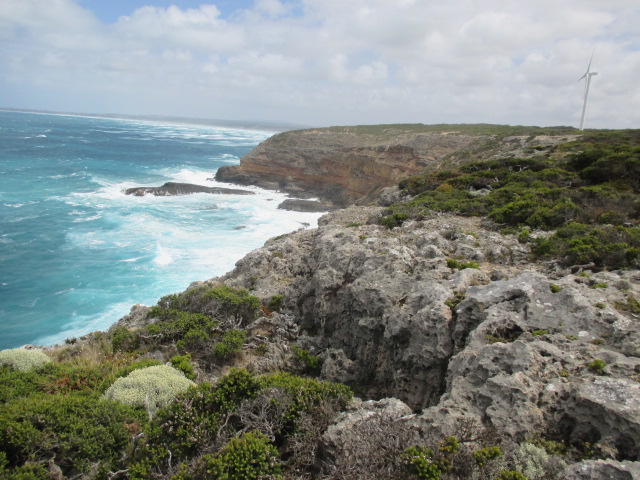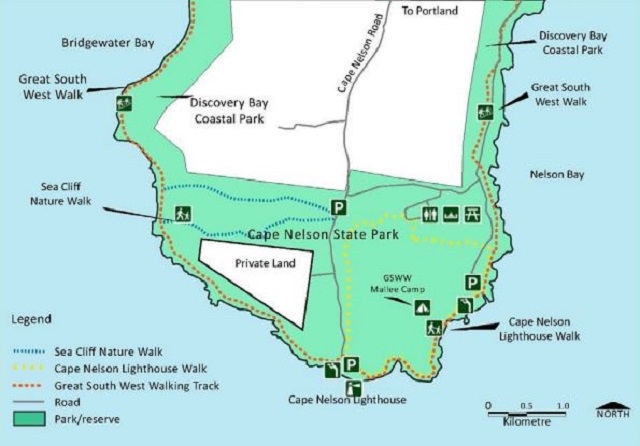Cape Nelson - Sea Cliff Nature Walk


This gentle 3km loop walk begins at the car park adjacent to the Cape Nelson Road and Scenic Road. It encompasses coastal scrub, cliff tops and views out to the Southern Ocean. It is a good introduction to the nature of Cape Nelson. Walkers should watch carefully for small spring flowering native orchids.
The Sea Cliff Nature Walk (3km), the Lighthouse Walk (6km) and the Great South West Walk offer excellent walking opportunities for everyone. All these walks are linked, providing the opportunity to walk as little or as much as desired.
Lighthouse Loop Walk - Twice the distance of Sea Cliff Nature Walk this is still a relatively easy walk with a little more preparation. Water, shoes, hat and sunscreen are essential. The full loop walk will take you through coastal heathland, Soap Mallee and several coastal outlook platforms.
Great South West Walk - Experience some of Australia's most beautiful scenery and wildlife on this great 250km loop walk. It also passes Point Danger where Victoria's only land-locked Gannets breeding colony is located.

Sea Cliff Nature Walk
1. Scratching about looking for food
Echidnas live on the Cape and are often active in spring and summer as they search for food. Along the track you will notice diggings and scratching in the soil. They dig and scratch with powerful claws and their holes often have 'finger-like' pointy-holes, a tell-tale sign that their snout has poked about looking for succulent ant-larvae.
Echidnas and platypus are monotremes - both unique to Australia/New Guinea. They have bird, reptile and mammal features, single opening rear end for all functions, they lay bird/reptile type eggs, are covered in fur and feed their young on milk. And they have beaks!
The spikes on the echidna are actually a type of hair (fur). They have two types of hair on their body; short for warmth and long 'spinelike' hair for tough protection.
2. Australia's floral emblem
Look about you, can you see the gum-leaf-like leaves? They are Australia's floral emblem, the Golden Wattle (Acacia pycnantha). Common to Australia and Africa, acacia or wattle seed is amazing as it can lie dormant in the soil for many years, waiting to germinate under the right conditions.
Fire greatly assists by providing the heat needed to break the hard outer layer of the seed. Ants harvest vast quantities of seed for food, carting it back into their underground chambers and Bronzewing pigeons enjoy them also.
3. Hiding under skirts
Of special interest in this area is the presence of grass trees (Xanthorrhoea australis) These amazing slow-growing plants are not actually grass. They can live for more than 100 years and send up a single large flower-spike, usually following fire, disturbance or drought. It can reach up to three metres. Small mammals such as the endangered Southern Brown Bandicoot will use the unburnt skirts (dead leaves) for protection from predators and weather.
4. An old survivor - Moonah
The old, gnarled tree behind the post at this stop is a Moonah (Melaleuca lanceolata). Due to this sheltered position it is much taller than the wind-blasted specimens that you will see later along the exposed ocean cliff tops. Moonah shows a remarkable ability to adapt to Cape Nelson's variety of conditions. Moonah stands were once widespread along the coasts of South West Victoria. Their wood
was highly prized for lime burning kilns and stands of old trees remain as natural treasures.
5. A mini-(or micro) forest
Look closely for patches of emerald-green moss. Moss is a miniature plant that grows in clumps or mini-forests. They can change colour and texture rapidly from a gold-colour to a soft lushgreen, depending on the availability of water. They are adapted to store water in their mat of spongy leaves/stems. They often become the seed beds for germinating seeds and are one of the plants that assist an area's transition from rock to soil.
6. Powerful unforgiving coastal winds
On the seaward side of the track is a small wedge of private open farmland. The bare and rocky areas on the rise are called dune limestone. This is the surrounding soils under-laying rock. It has been exposed as a result of the plant cover being removed and the wind sweeping the sand cover away.
7. Less soil, smaller plants
Spreading Flax Lilies (Dianella revoluta) and other native grasses cover this open rocky area. Their springtime displays of delicate blue flowers mature to form blue/purple berries; a favourite food for birds and animals living here.
8. Adapting to survive - droopy but healthy
You may not have noticed a new plant appearing along this track. The Drooping Velvet Bush (Lasiopetalum schulzenii) is extremely rare and Cape Nelson is one of the few areas where it still occurs locally. Although it may appear to be drooping from lack of water this is in fact a trick. This plant is able to droop its leaves in order to prevent excessive water-loss through evaporation, this is a survival mechanism for living in this area.
9. Stunted runts - 'Bonsai' on the coast
There would be few places that humans can stand and be taller than gum trees (eucalypt species), but this is one of them! This entire area is subject to the pounding of strong salt-laden winds which cut back and suppress growth. The canopy itself is still thick - protecting under-laying plants and animals. Some plants appear to be bonsai (miniature) as they are unable to grow tall due to pruning by the strong harsh salty winds.
10. Looking towards Bridgewater Bay and Cape Bridgewater
You are looking out at the enormous Southern Ocean - stretching south to the shores of Antarctica almost 3000km away. The ocean is home to some well known locals; tuna fish, whales, dolphins, sea eagles and the Australasian Gannet. On most days you can see gannets skimming above the ocean waters and then diving suddenly to plunge in search of fish. They roost and breed in great numbers at nearby Lawrence Rocks.
11. What's under your feet?
In the headland further along two distinct layers of rock can be seen. Also noticeable at Cape Nelson Lighthouse, the cliffbase is dark coloured basalt (bluestone), a result of lava flow from an ancient volcanic eruption. On top is the lighter coloured limestone, deposited more recently.
12. A haven for small birds
Stop, look and listen quietly. Scrub wrens, Rufous Bristlebirds, wrens, finches and King Quail are just some of the birds you may see or hear in this ideal habitat.
13. Soap Mallee
This area is dominated by a canopy of thick Soap Mallee (Eucalyptus diversifolia) which is restricted to Cape Nelson in Victoria (it is more common in South Australia). Like other mallee eucalypts, Soap Mallee has no single trunk but a large woody rootstock from which several stems grow. After a fire, new growth sprouts from the rootstock protected beneath the soil.
14. Strange mounds
Take note of the old windrows as you follow the trail. These are all that remains after land clearing in 1968.
15. When the soil changes, the plants often do too
You will see the plants have changed to mostly tea-tree species providing home and shelter for many small birds and masses of insects (which in turn are food for birds and animals). Heath Tea-tree (Leptospermum myrsinoides) and Prickly Tea-tree (Leptospermum continentale) both produce masses of white spring and summer wildflowers.
Facilities and Accommodation
Two scenic bushwalks. A picnic area, fireplaces, tables, toilets, a self-guided walk and lighthouse are available. No camping except for Great South West Walk (GSWW) registered hikers. Camping fees apply. Enquire at Portland's Maritime Discovery Centre for camping and other local information.
Location and Access
Travel from Portland on the Cape Nelson Road for 11km. It is 377km south-west from Melbourne, and 562km south-east of Adelaide.
Review:
This is a lovely walk, initially through the coastal vegetation and then reaching the spectacular sea cliffs. Take a copy of the Sea Cliff Nature Walk notes (download link below) because there are numbered posts on the walk corresponding to the information in the notes. This helps to make the walk more interesting for the kids.
The section of the walk along the cliff tops is quite short but can be very windy and cold and it might be worth bringing along some extra clothes for that section. When we went on the walk the wind was extremely strong and there is a section of the trail close to the edge. Thankfully the wind was blowing from the cliff edge rather than towards the cliff edge. This bit could be a bit scary for some people. Generally the walk is fairly well protected from the wind.
The path splits at one point near the cliffs between the Sea Cliff Nature Walk and a track to the Lighthouse.
The path is fairly flat but is quite sandy in places and there are lots of little holes from digging animals (probably echidnas which are quite common in the area - we saw one on the path and another one beside the road while driving to the walk)
Photos:
Location
Cnr Cape Nelson Lighthouse Rd and Scenic Rd, Portland 3305 Map
Web Links
→ Cape Nelson State Park (Parks Victoria)
→ Cape Nelson State Park - Sea Cliff Nature Walk (PDF)











